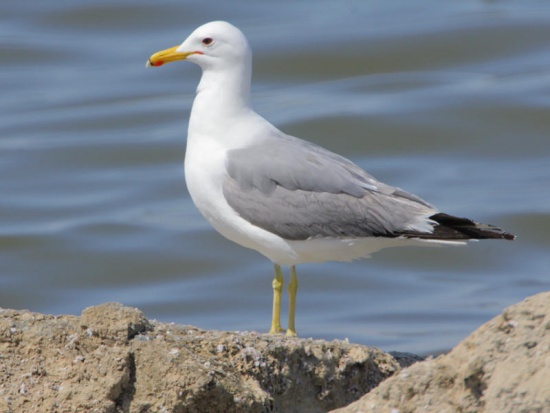- Larus californicus
Identification
A medium sized white-headed gull, in between Ring-billed Gull and Herring Gull with darker grey back, yellow legs, dark eye, and red and black marks on slightly longer bill than Ring-billed.
Similar Species
Ring-billed Gull is smaller with lighter back, pale eye, and broad black ring on bill. 1st winter Ring-billed similar to 2nd winter California but back much lighter grey, and pink legs (California 2nd winter have blueish legs).
Herring Gull is much larger Adult similar but with larger bill with red spot but no ring, pink legs, pale eye, more extensive streaking on neck.
Distribution
Breeds in the great plains and rocky mountain regions of the United States and Canada. Winters along the pacific coast from British Columbia south to Mexico. Rare but regular vagrant to Texas. Casual vagrant to eastern United States.
Accidental vagrant to Alaska, Yukon Territory and Japan.
Taxonomy
Subspecies[1]
This is a polytypic species consisting of two subspecies:
- L. c. californicus:
- Eastern Washington to Wyoming; winters to southern Mexico
- L. c. albertaensis:
- Southern Mackenzie, Alberta and western Manitoba to South Dakota
Habitat
Breeds in open habitats in the arid interior, usually on low rocky islands in both freshwater and saline lakes as well as salt ponds locally along the coast. in winter uses every habitat from the waters at edge of continental shelf to beaches and rocky coasts, mudflats, coastal estuaries, and deltas of rivers and streams.
Behaviour
Breeding
They nest in a shallow depression on the ground lined with vegetation and feathers. The clutch consists of 2-3 eggs which are tended both parents.
Diet
Their diet includes insects, fish and eggs. They also scavenge in rubbish dumps.
Vocalisation
The long call is higher-pitched and harsher than that of Herring Gull. Includes a gradually descending and shortening series of kyow notes.
Movements
Moves to the Pacific Coast from interior breeding sites.
References
- Clements, J. F., T. S. Schulenberg, M. J. Iliff, S. M. Billerman, T. A. Fredericks, B. L. Sullivan, and C. L. Wood. 2019. The eBird/Clements Checklist of Birds of the World: v2019. Downloaded from http://www.birds.cornell.edu/clementschecklist/download/
- Winkler, D. W. (2020). California Gull (Larus californicus), version 1.0. In Birds of the World (A. F. Poole and F. B. Gill, Editors). Cornell Lab of Ornithology, Ithaca, NY, USA. https://doi.org/10.2173/bow.calgul.01
- Burger, J., Gochfeld, M., Kirwan, G.M. & Garcia, E.F.J. (2020). California Gull (Larus californicus). In: del Hoyo, J., Elliott, A., Sargatal, J., Christie, D.A. & de Juana, E. (eds.). Handbook of the Birds of the World Alive. Lynx Edicions, Barcelona. (retrieved from https://www.hbw.com/node/53973 on 19 March 2020).
- Howell, S.N.G. & Dunn, J.L. (2007) Gulls of the Americas. Houghton Mifflin, Boston.
- Malling Olsen, K. & Larsson, H. (2003) Gulls of Europe, Asia and North America. Christopher Helm, London.
- Wikipedia contributors. (2020, January 26). California gull. In Wikipedia, The Free Encyclopedia. Retrieved 07:26, March 19, 2020, from https://en.wikipedia.org/w/index.php?title=California_gull&oldid=937628106
Recommended Citation
- BirdForum Opus contributors. (2024) California Gull. In: BirdForum, the forum for wild birds and birding. Retrieved 15 May 2024 from https://www.birdforum.net/opus/California_Gull






